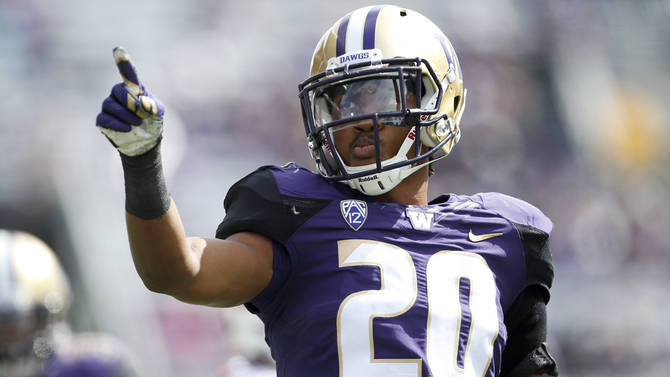When the Packers' season came to its inglorious end on the Georgia Dome turf in the NFC Championship Game, Damarious Randall and Ladarius Gunter had played virtually every snap at cornerback. Randall, the team's 2015 first-round pick, and Gunter, a 2015 undrafted free agent, had been forced into extensive duties because of injuries. And while the hope is that their trial-by-fire experiences will serve them well going forward, both were routintely exposed down the stretch last season.
Among all NFL cornerbacks, Gunter ranked 97th and Randall ranked 108th, according to Pro Football Focus.
Against the Falcons, the Packers allowed Matt Ryan to throw for 392 yards and four touchdowns, and didn't register a sack. Put another way: In addition to cornerback, there is a need for a pass rusher because Clay Matthews can't do it all. And while Ty Montgomery is a great story, Green Bay needs depth at running back too.
Let's take a look at how the perennial favorites in the AFC North made out over draft weekend.
Packers addressed their biggest need
It was pretty cut and dried: There was a glaring need at cornerback, and the Packers addressed it. Not only that, they picked up an additional fourth-round pick for their troubles when they moved back four spots, allowing the Browns to have the 29th selection. With pick No. 33, Green Bay took Kevin King, a 6-foot-3 press corner who checks all the boxes. King is the prototype you draw up to slow down the Julio Joneses of the NFL world. (This is where we mention that Jones had nine receptions for 180 yards and two touchdowns in the NFC title game.)
"I watched that [game]," King told reporters on a conference call after he was drafted. "That was a -- I mean, that was interesting one."
That's the diplomatic answer.
"One of our goals this year was to try and get faster," Packers director of football operations Eliot Wolf said Friday after selecting King. "I think we got the tallest corner in the draft and a guy that runs really fast and a guy that can make plays on the ball. We're really excited about it."
King is more than a tall drink of water; he blazed a 4.43 40-yard dash at the combine in February.
"We've never had a guy here that's been a 6-3 corner, so we're really excited to get to work with him and see what he can do," Wolf added.
Eighteen picks later, the Packers were back on the clock and back to fixing the secondary; they selected 6-1, 220-pound safety Josh Jones, who ran a 4.41 40 at the combine. Jones will replace Micah Hyde in a defense that is suddenly much faster -- and that's by design.
"I think you're always trying to get faster," general manager Ted Thompson said. "I don't think it's a negative thing. Football is about explosiveness, speed, athletic ability. This is not our grandfather's football that we're playing in this day and age. Everybody's fast, everybody's explosive and I think that's what we're trying to get at."
It might seem odd that the Packers used a second-round pick on safety when they already have Ha Ha Clinton-Dix and Morgan Burnett, but in a league where offenses run three (or more)-wide receiver sets more than half the time, you can never have enough capable defensive backs. Plus, Jones' addition means that Burnett might play more inside linebacker in the Packers' nickel defense, which he did last season.

What about a pass rusher, or the offensive line?
Clay Matthews has registered double-digit sacks once in the past four seasons, in 2014. Yes, Nick Perry had 11 sacks in 2016, but with Julius Peppers and Datone Jones gone, that's it for the Packers' pash-rushing threats. Which is why finding another pass rusher was on the team's to-do list. Green Bay passed on outside linebacker T.J. Watt with the No. 29 selection, and instead traded down to take King four picks later. And while cornerback was a more pressing need, the Packers didn't get around to drafting an edge rusher until Round 4, when they took Watt's teammate at Wisconsin, Vince Biegel. The bad news: Biegel only had four sacks last season. The good news: He had 15.5 sacks the previous two seasons, when Watt was limited by injuries.
You could argue that the Packers also addressed this need in Round 3, when they selected defensive tackle Montravius Adams. Yes, he plays in the interior of the defense, and yes, he's listed at 6-3, 304 pounds, but he also blazed a 4.87 40 at the combine. Adams, who can play every position on the defensive line, ended his Auburn career with 13 sacks and 57 hurries, and he'll complement Mike Daniels and Kenny Clark (Daniels had four sacks in '16).
On the other side of the ball, the Packers let right guard T.J. Lang and interior lineman JC Tretter walk in free agency. Josh Sitton's replacement, Lane Taylor, is entering a contract year, as is center Corey Linsley. And while the Packers used a 2016 second-round pick on Jason Spriggs, he played on just 22 percent of the snaps last season. The team did sign Jahri Evans on a one-year deal.
So it wasn't a surprise that Green Bay drafted an offensive linemen, though it didn't happen until the sixth round, when South Florida's Kofi Amichia was selected. Amichia fits the profile of a college tackle who will move inside for the Packers.
Were they right to pass on Dalvin Cook?
Four years ago, the Packers drafted Eddie Lacy late in the second round. By that point, Giovani Bernard, Le'Veon Bell and Montee Ball had already come off the board. Ball hasn't had a regular-season carry since 2014, Bernard has been a steady contributor in Cincinnati and Bell has morphed into one of the league's most dynamic backs. Lacy, who struggled with his weight and injuries, wasn't re-signed this offseason and now he's in Seattle. The Packers had an opportunity to replace Lacy at the end of the first round with Florida State's Dalvin Cook, who is as dangerous catching passes as he is taking handoffs. Instead, Green Bay traded down to fill a bigger need in the secondary.
But was that the right move?
Funny story: According to Bob McGinn of the Milwaukee Journal Sentinel, the Packers were down to King and Cook but went with King because he was a "safer, cleaner pick." Cook lasted until the 41st selection, when the Vikings moved up to grab him.
But the Packers, well aware of needs in the backfield, didn't stand pat; they selected three running backs on Day 3, starting with BYU's Jamaal Williams, who is listed at 6 feet and 212 pounds and is downhill runner who has drawn comparisons to James Starks. Green Bay also selected UTEP's Aaron Jones in Round 6 and Utah State's Devante Mays in Round 7.
Put another way: The Packers will have a backs-by-committee approach in 2017, spearheaded by Ty Montgomery.
The final analysis
It's a simple formula. As has been the case in the Aaron Rodgers era, it starts with ... Rodgers (duh), and whether the offensive line can protect him. If that happens, the Packers are hard to beat. Things get complicated when the O-line struggles to keep him upright (the unit ranked 11th in pass protection last season, according to Football Outsiders) and the defense can't get off the field (they ranked 20th overall, 22nd against the pass last season).
The front office, coaching staff and scouts are well aware of these shortcomings, which explains the addition of Evans to the offensive line and a defense-focused draft class that addresses the biggest needs: the secondary, edge rusher and running back. And oh by the way, the Packers also signed tight end Martellus Bennett, who will go a long way toward simplifying Rodgers' life. If it all comes together, the Packers will not only be favorites to win the division, but the Falcons' biggest threat to represent the NFC in the Super Bowl.

















